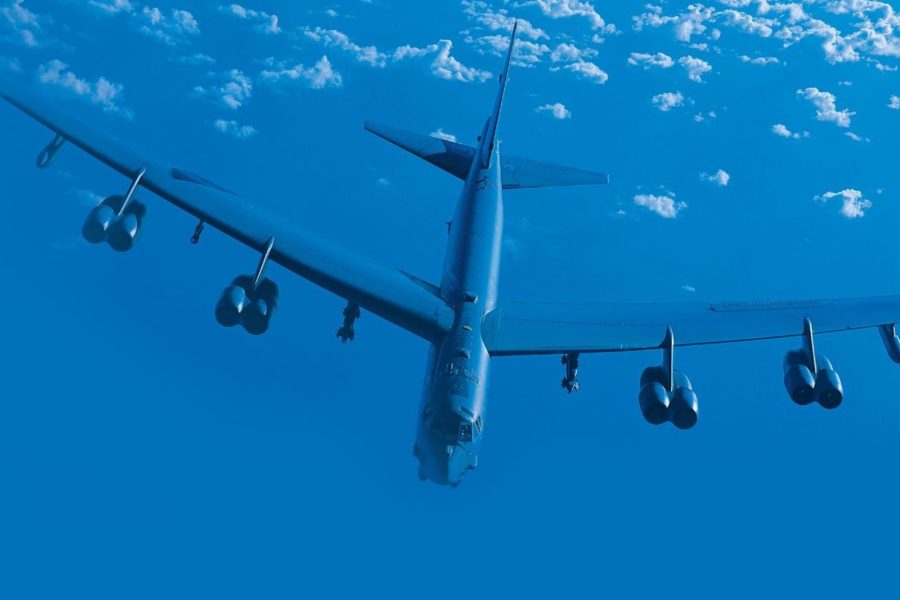OKLAHOMA CITY—There will be “some” cost increase on the B-52 Commercial Engine Replacement Program (CERP) when it gets its new official baseline this fall—but concerns about a massive spike are unfounded, program officials said.
The new baseline will come as officials decide whether the program is ready for the engineering and manufacturing development phase, and it will add money to what had not previously been a fully-funded project, officials told reporters at the Oklahoma City Air Logistics Complex. But the new cost and schedule baseline have not yet been finalized.
The venerable B-52 is slated to not only get new engines in the coming years, but new engines, communications, and navigation gear too.
The centerpiece has been the CERP, though, and some in Congress voiced concerns last year that the program cost would jump 50 percent.
Air Force material lead Col. Louis Ruscetta said those reports are based on issues “taken out of context” and are inaccurate.
“There have been no Nunn-McCurdy breaches” on the CERP effort, he said. Under the Nunn-McCurdy law of 1982, if a program sees a 25 percent cost increase over current baseline, or a 50 percent increase over original estimates, it must be canceled.
The B-52 re-engining program won’t actually have a program baseline until Milestone B—which evaluates readiness for entry into the EMD phase phase—because it has until now been a Middle Tier of Acquisition program, Ruscetta said. Congress gives the services MTA authorities to speed up programs when a technology is sufficiently mature to skip some preliminary steps.
The B-52’s new engine—the Rolls Royce F130-200—is based on an existing engine already widely in use. Development in the program is largely focused on integrating the engine with the B-52’s wing, engine pylon, and cockpit controls.
The CERP is “graduating” to a “Major Capability Acquisition” with Milestone B, Ruscetta said.
“The projected cost of the program has increased in the last couple of years, as we know more,” Ruscetta said.
There has also been a reduction in expected fuel efficiency of the new engines, from the previous target of 30 percent improvement over the current TF33 engines to about 20 percent, Ruscetta acknowledged. However, fuel efficiency was not a key discriminator on the contract, which was weighted toward reliability, reduced maintenance, and expected ease of integration with the bomber.
The expected cost increase has also come as the program has matured, Ruscetta said—as the Air Force has gotten more suppliers on contract, “we understand where those costs are phased, and so then we can add money within the time of the (President’s Budget) … for me to match that phasing when it’s required.”
The Air Force’s fiscal 2024 budget request indicated about a $220 million increase over the next five years, but Ruscetta said the B-52 CERP “early on … was not fully funded.”
Now that it’s going to be a major acquisition program, the Air Force must create the new cost baseline and “certify … that all the funding’s available to the program,” Ruscetta said, adding that the service has “had a plan to lay that in in future years.”
Ruscetta added that the fiscal 2023 budget didn’t include complete development funding.
All of that will change this fall, when the Air Force reaches Milestone B. As part of that decision, the service will set a program baseline and a service cost position, explaining how and when it will fund the program.
At that point, “we have better independent cost estimates” from the Pentagon’s Cost Assessment and Program Evaluation (CAPE) shop, Ruscetta said, “as well as actual contract information from subcontractors … so we have a much more mature scope of the program.”
Milestone B is where programs are expected to have sufficient maturity to nail down cost and schedule and “actually grade yourself” on meeting those marks, Ruscetta said.
Although development costs will be higher in the new baseline, there will likely be reductions in estimated production costs, Air Force material lead Col. Louis Ruscetta said.
The milestone review and Air Force readiness will benefit from the digital design of the CERP upgrade now being at “Increment Two,” said Jennifer Wong, Boeing director of bomber programs.
Increment One was “engine-agnostic” for the integration of the B-52’s new systems, Wong said, because the engine had not yet been selected when that digital design was built. Now that the F130-200 is plugged into the design, “it is a much more mature virtual prototype,” she said, with additional features that were not included in the original version.
That helps with readiness because the Air Force will soon be able to start training maintainers to work on the upgraded power system, Ruscetta said, and they’ll be ready to go when the B-52 begins test flights with new engine. The Virtual Training System “has already started to deliver” to Global Strike Command and Air Education and Training Command, he said.
“They can start developing their tech manuals [and] their training curriculum. And all of that is happening now, pre-Milestone B.” Usually, he said, “that doesn’t start happening until you’ve actually modified the aircraft and you’re in flight test. So we can start that four years early. That is a key enabler and game-changer.”
